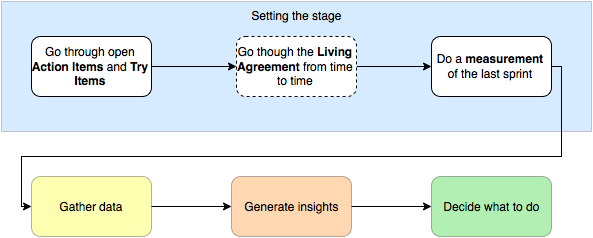What to do in your retrospectives?

I already gave a short overview of retrospectives in the context of software engineering teams. There are several books for this available and I won't go into detail about this. What I would like to focus on in this article is how we in our family do weekly retrospectives. Of course, our approach is influenced by some literature out there.
The goal
For me the goals in our retrospectives are to identify issues, to learn from mistakes and to improve as a family.
The structure
The following structure might look really formal and over-engineered. However, I would like to give you a clear picture on what we do. Feel free to skip parts that do not make sense for you.

Setting the stage
- First, you should go through any open action items and try items. I will explain later on what those are.
- Read through the living agreement from time to time and check if the items on there are still helpful and valid.
- Do a measurement of the last sprint. This can be a number from one to ten or any other kind of scale you like. It could also be a drawing of each participant expressing her mood. This gives a first hint about how the sprint went and can be used to track the development of your family/team. You can also use this to analyze the influence of certain events during the week on your success in the sprint.
Gather data

Give each participant a certain number of sticky notes or any other kind of small sheets of paper. Each participant needs sheets for two categories: things that went well during the sprint and things that need improvement. In my family we use three sheets of paper for each category. Limiting the number ensures that not too many items for only one category are used (i.e., mentioning only things that need improvement feels bad) and that the retrospective is kept short and focused on not too many topics. If you like you can color code the sheets.
Now, set and start a timer (we use three minutes for this task). In the following period of time each participant uses the sheets of paper to write down things that felt good during the sprint and that need improvement. Those can be solely private things or things that also concern the other participants and the family (which would be awesome as the goal is to improve as a family).
Generate insights

If time is up participants stop writing and present their topics one after the other. In each retrospective somebody else should start doing this. Start clustering the topics, maybe multiple participants have experienced similar issues or things that went well during the sprint. Depending on the number of things you can either vote on which topics to talk about or just take all topics into the discussion.
Now, one topic after the other, talk about it in the group. Be sure to also include the good things in the discussion, praise them! Talking only about the bad things feels sad, right? Sadly, people tend to remember the bad things better than the good stuff.
Decide what to do

In this part of the retrospective, try to focus on what and how you can improve working together. If you discuss something and want to make it a habit consider creating a try item out of it. A try item could be “Try to pick up the trash when I recognize it is full.” Review try items on a defined date/retrospective.
As the name suggests try items are things written down to try for some period of time. When creating one be precise and include what to try, the one who tries it out and a date when the try item has to be reviewed again. Write the try item down and put it where it is visible for everybody.
If during the discussion something comes up that needs following up write an action item. An action item could be “Store/backup the pictures of our weekend trip on the file server.” An action item needs a due date and an owner. Write those down and have it visible.
Summing up
This is the bare bone of each of our retrospectives. After this everybody should have a clear understanding of how the other family members felt during the sprint and how the next sprint can be even better! Of course, the bare bone can be adapted and things important to your family can be added.
I promise to write an article about what you can do to make retrospectives diversified and how to involve all participants even better.
Post image taken by me, published under CC BY-SA 4.0.





